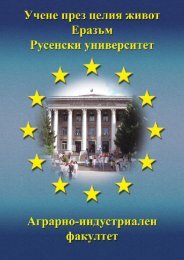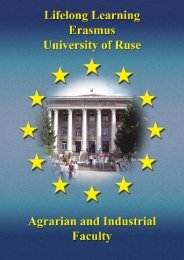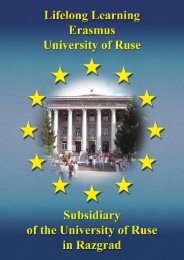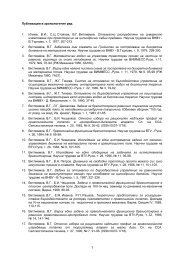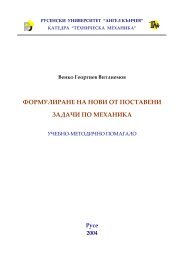Erasmus ECTS Information Package
Erasmus ECTS Information Package
Erasmus ECTS Information Package
You also want an ePaper? Increase the reach of your titles
YUMPU automatically turns print PDFs into web optimized ePapers that Google loves.
<strong>Erasmus</strong> <strong>ECTS</strong> <strong>Information</strong> <strong>Package</strong><br />
Faculty of EEEA<br />
3036 Analysis and Synthesis of Logic Circuits<br />
<strong>ECTS</strong> credits: 6<br />
Weekly classes: 2lec+0sem+0labs+3ps+0,5p<br />
Assessment: exam<br />
Type of exam: written<br />
Department involved:<br />
Dept. of Theoretic and Measuring Engineering;<br />
Faculty of Electrical Engineering, Electronics and Automation<br />
Lecturers:<br />
Assoc. Prof. Svilena Vasileva Todorova, MEng, PhD, Dept. of Industrial Management, tel.: 888 265,<br />
E-mail: Svito@uni-ruse.bg<br />
Principal Assistant Vladimir Mateev Mateev, PhD; Dept. of Physics, tel.: 888 583, E-mail: vmateev@uni-ruse.bg<br />
Senior Assistant Adriana Naydenova Borodzhieva, Dept. of Telecommunications, tel.: 888 734,<br />
E-mail: ABorodjieva@ecs.uni-ruse.bg<br />
Abstract:<br />
The Analysis and Synthesis of Logic Circuits course aims at familiarizing the students with the main rules and<br />
methods for design and analysis of logic networks, as well as with the theory of finite automata, presented in<br />
accordance with its application in the engineering methods for design and analysis of sequential networks.<br />
Course content:<br />
Boolean algebra: objects, operations, postulates, basic laps and theorems. Boolean functions; functional<br />
completeness. Logic gates. Minimum forms of switching functions. Simplification of incompletely specified<br />
functions. Combinational network design. Multi-level gate networks. Multi-output networks. Design with different<br />
types of logic gates. Static and dynamic analysis of combination networks. Binary adders, decoders, encoders,<br />
multiplexers, code converters. Sequential networks - main concepts. Flip-flops. Sequential networks design.<br />
Registers, counters. Analysis of clocked sequential networks. State machine design with algorithmic state machine<br />
charts.<br />
Teaching and assessment:<br />
The teaching process is divided into lectures, practice classes and controlled self-dependent work (course paper).<br />
An active and regular participation in the learning process is required for validating the semester. The students can<br />
get up to 5 points for their participation in the lectures, up to 10 points for their work in the laboratory and up to 5<br />
points for theis course paper presentation. They can get up to 80 points for their exam presentation. The common<br />
number of points is to be turned into a mark based on a grading scheme of 6. If a resit has to be taken, the points<br />
from the semester work are not valid. The resit is written, too.<br />
3064 WEB Design<br />
<strong>ECTS</strong> credits: 5<br />
Weekly classes: 2lec+1sem+0labs+3ps+1ca<br />
Assessment: continuous assessment<br />
Type of exam: written<br />
Department involved:<br />
Department of Computing<br />
Faculty of Electrical Engineering, Electronics and Automation<br />
Lecturers:<br />
Assoc. Prof. Georgi Todorov Georgiev, MEng, PhD, Dept. of Computing; tel.: 888 744<br />
E-mail: GTGeorgiev@ecs.uni-ruse.bg<br />
Abstract:<br />
The course objective is to familiarize the students with the underlying technologies for creating a Web site<br />
(personal or for an SME) as well as with the good practices for achieving Web content accessibility, usability and<br />
credibility. A side objective of the course is to give the students hands-on experience with a Web content creation<br />
environment, such as Microsoft FrontPage and/or Macromedia DreamWeaver.<br />
Course content:<br />
A short history of Internet. Basic services and WWW. Introduction to HTTP. HTML. The need for stricter standards<br />
- from HTML to XHTML and benefits of the latter. Separating the document structure from the presentation - CSS.<br />
Client-side programming - the ECMAScript / JavaScript language. The Document Object Model (DOM).<br />
Fundamental design goals of a Web site - accessibility, usability and credibility. Publishing and publicising a Web<br />
site.<br />
Teaching and assessment:<br />
Lectures are given as multimedia presentations. The students have specific tasks to solve in each practice<br />
session, using FrontPage or DreamWeaver. In the course of the semester, the students gradually build a complete<br />
site, enhancing it in each practice session. Each student is assigned an individual task, which they have to<br />
complete by the end of the semester. The final mark is a weighted average of three marks: activity during practice<br />
sessions, implementation of the individual task, and a written report.<br />
154



